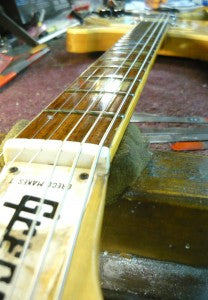Greco RG550
Share
I'm a huge fan of most things Greco and I do love their Ric copies. Their construction is identical to whatever it is they're copying and the Ric copies are no exception, and like most things Japanese, when they copy something, they copy the "mistakes" and faults too.
Because they make all the hardware to match what they copy, most of the parts are almost "exact" except for being metric instead of imperial in most cases.
This one came in for refret, a new bridge, nut and set up and some electronics work. As with most "refrets" I generally end up talking the owner out of it unless it's absolutely necessary and this one wasn't. I'm not a big fan of refrets for the sake of it. It costs you more money, it takes up more of my time and it can change the way your favorite guitar plays and sounds.
So, with the nut off I went to work on a fret dress to level the frets and take some of the grooves out of the lower position frets. These have a lot of finish on the fretboard which adds to the feeling that they have low frets but this still had lots of good usable fret left.
There was a fair bit of "rot" around the nut and trussrod slot from what looked like moisture ? Once the nut was off it was clear there was a crack in the neck between the neck and fretboard. This is also common on real Rics due to the construction.
Rics (and these) have very thin necks and thick fretboards. This is a very "German" way of making guitars. There is less headstock angle and because the fretboard is thicker, the strings sit higher off the face of the headstock, giving a better break angle. This method works well, but because of the thin neck, any tension around this area can make the fretboard come away from the neck, especially if the trussrod has been over adjusted.
It looked like it had been cracked for some time which would have effected tuning stability and also meant the crack was full of oil and dirt which needed to be cleaned out before I could glue it. I used wedges to open the crack to clean it out. Once it was clean, it was a simple matter of gluing and clamping.
Because of this method of construction, the nut needs to have a small recess under it to accommodate the truss rod. So next up was to cut a new nut.
With the new nut sorted and the new bridge in place and slotted it was pretty much a set up from here on in. The construction and parts of a Ric (or copy) are a big part of that tone. These are great bridges with good adjustment and the "floating" pickups add to the "hollow" jangly tone.
The tailpiece, which is essentially a "trapeze" style adds to the sound as well and Greco make the great "G" style instead of the "R" to complete the package. Very nice.
I love Rics and they're good quality copies like this. I've played some Greco copies that I like more than some real Rics I've played. The way the Japanese copy these is just great.
So, the electrics were fixed up and the guitar set up and ready to go.














